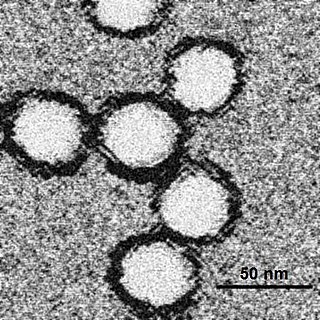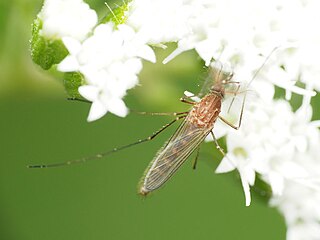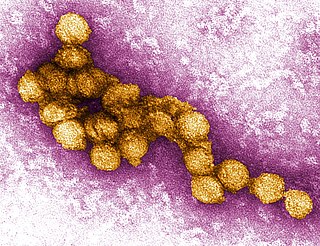
Mosquitoes are approximately 3,600 species of small flies comprising the family Culicidae. The word "mosquito" is Spanish for "little fly". Mosquitoes have a slender segmented body, one pair of wings, one pair of halteres, three pairs of long hair-like legs, and elongated mouthparts.

West Nile fever is an infection by the West Nile virus, which is typically spread by mosquitoes. In about 80% of infections people have few or no symptoms. About 20% of people develop a fever, headache, vomiting, or a rash. In less than 1% of people, encephalitis or meningitis occurs, with associated neck stiffness, confusion, or seizures. Recovery may take weeks to months. The risk of death among those in whom the nervous system is affected is about 10 percent.

Aedes albopictus, from the mosquito (Culicidae) family, also known as the (Asian) tiger mosquito or forest mosquito, is a mosquito native to the tropical and subtropical areas of Southeast Asia. In the past few centuries, however, this species has spread to many countries through the transport of goods and international travel. It is characterized by the white bands on its legs and body.

Aedes aegypti, the yellow fever mosquito, is a mosquito that can spread dengue fever, chikungunya, Zika fever, Mayaro and yellow fever viruses, and other disease agents. The mosquito can be recognized by black and white markings on its legs and a marking in the form of a lyre on the upper surface of its thorax. This mosquito originated in Africa, but is now found in tropical, subtropical and temperate regions throughout the world.

The London Underground mosquito is a form of mosquito in the genus Culex. It is found in the London Underground railway system as its name suggests, but has a worldwide distribution and long predates the existence of the London Underground. It was first described as a distinct species from Egyptian specimens by the biologist Peter Forsskål (1732–1763). He named this mosquito Culex molestus due to its voracious biting, but later biologists renamed it Culex pipiens f. molestus because there were no morphological differences between it and Culex pipiens. Notably, this mosquito assaulted Londoners sleeping in the Underground during the Blitz, although similar populations were long known.

Culex pipiens is a species of mosquito commonly referred to as the common house mosquito or northern house mosquito, as it is the most common mosquito to the northern regions of the US. They can be found in both urban and suburban temperate and tropical regions across the world.

Culex restuans is a species of mosquito known to occur in Canada, the United States, Mexico, Guatemala, Honduras, and the Bahamas. It is a disease vector for St. Louis encephalitis and West Nile virus. In 2013 West Nile Virus positive specimens were collected in Southern California.

Culex quinquefasciatus, commonly known as the southern house mosquito, is a medium-sized mosquito found in tropical and subtropical regions of the world. It is a vector of Wuchereria bancrofti, avian malaria, and arboviruses including St. Louis encephalitis virus, Western equine encephalitis virus, Zika virus and West Nile virus. It is taxonomically regarded as a member of the Culex pipiens species complex. Its genome was sequenced in 2010, and was shown to have 18,883 protein-coding genes.

Anopheles sinensis is a species of mosquito that transmits malaria as well as lymphatic filariasis. It is regarded as the most important vector of these human parasitic diseases in Southeast Asia. It is the primary vector of vivax malaria in many regions. In China it also transmits the filalarial parasite, and arthropod roundworm. In Japan it is also a vector of a roundworm Setaria digitata in sheep and goats.
Culex vishnui is a mosquito belonging to the Culicidae family. It is the most common vector (carrier) of the Japanese encephalitis virus (JEV) in India, Sri Lanka, Thailand, and Sarawak.
Aedes vittatus is a species of mosquito that was first described in 1861 as Culex vittatus from specimens collected on Corsica. In 2000, the species was transferred to the newly erected subgenus Fredwardsius as the type species representing the subgenus.

Aedes japonicus, commonly known as the Asian bush mosquito or the Asian rock pool mosquito, was first described by Theobald in 1901 from Tokyo, Japan. They are competent arbovirus vectors known to transmit the West Nile virus as well as Japanese and St. Louis encephalitis. They are listed as an invasive species by the Global Invasive Species Database.

West Nile virus (WNV) is a single-stranded RNA virus that causes West Nile fever. It is a member of the family Flaviviridae, from the genus Flavivirus, which also contains the Zika virus, dengue virus, and yellow fever virus. The virus is primarily transmitted by mosquitoes, mostly species of Culex. The primary hosts of WNV are birds, so that the virus remains within a "bird–mosquito–bird" transmission cycle. The virus is genetically related to the Japanese encephalitis family of viruses. Humans and horses both exhibit disease symptoms from the virus, and symptoms rarely occur in other animals.
Mansonia (Mansonioides) annulifera is a species of zoophilic mosquito belonging to the genus Mansonia.
Culex (Lutzia) fuscanus is a species of mosquito belonging to the genus Culex. It is found in China, India, Indonesia and Sri Lanka They are natural predators of disease causing mosquito larva such as Aedes aegypti, Anopheles subpictus, and Culex tritaeniorhynchus.

Culex (Culex) gelidus is a species of mosquito belonging to the genus Culex. It is found in India, Sri Lanka, Bangladesh, Cambodia, China, Hong Kong, India, Indonesia, Japan, Laos, Malaysia, Myanmar, Nepal, New Guinea (Island); Papua New Guinea, Pakistan, Philippines, Taiwan, Thailand, Vietnam. In 1976, it was identified as a major vector of Japanese encephalitis virus, in India. From an experiment, it was evident that aqueous solution of Calotropis gigantea leaves possess larvicidal activity, mosquito repellent activity and ovicidal activity against Culex gelidus.
Culex (Oculeomyia) infula is a species of mosquito belonging to the genus Culex. It is found in Bangladesh, India, Indonesia, Malaysia, Myanmar, Nepal, Philippines, Singapore, Sri Lanka, Thailand, and Vietnam. Adults mainly feeds on cattle but infrequently shows a low proportion of human and bird blood meals. Larvae can be found in water courses with high content of algal populations. In 1998, the species was identified as a vector of Japanese encephalitis virus.
Culex (Culex) pseudovishnui is a species complex of mosquito belonging to the Culex vishnui group of the genus Culex. It is found in Bangladesh, Cambodia, China, Hong Kong, India, Indonesia, Iran, Iraq, Japan, South Korea, Laos, Macau, Malaysia, Nepal, New Guinea (Island); Papua New Guinea, Pakistan, Philippines, Singapore, Sri Lanka, Thailand, Taiwan and Vietnam. It is a major vector of West Nile virus, and Japanese encephalitis virus Larvae can be found from the edges of rice fields. Adults can bite vertebrates from both indoor and outdoor places with a peak biting time on 7pm onwards.

Aedes taeniorhynchus, or the black salt marsh mosquito, is a mosquito in the family Culicidae. It is a carrier for encephalitic viruses including Venezuelan equine encephalitis and can transmit Dirofilaria immitis. It resides in the Americas and is known to bite mammals, reptiles, and birds. Like other mosquitoes, Ae. taeniorhynchus adults survive on a combination diet of blood and sugar, with females generally requiring a blood meal before laying eggs.

Aedes scapularis is a species of mosquito primarily found in neo-tropical regions of the Americas.















